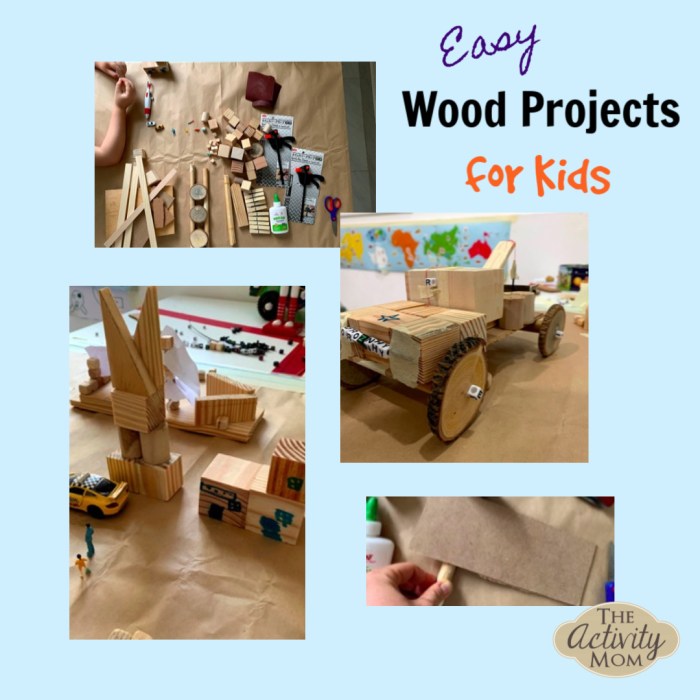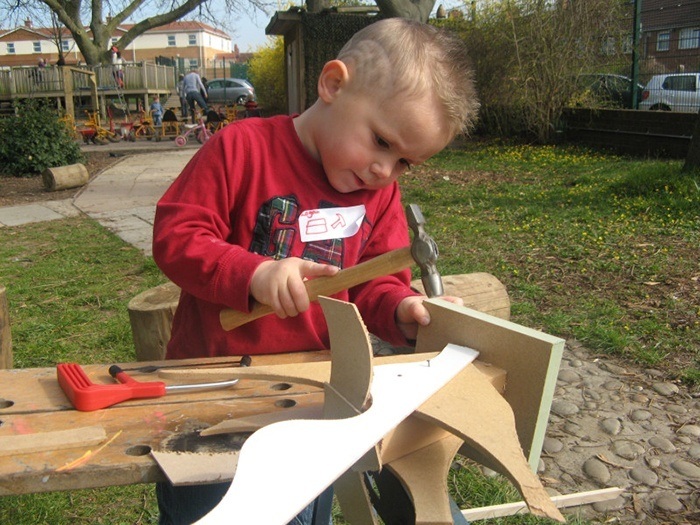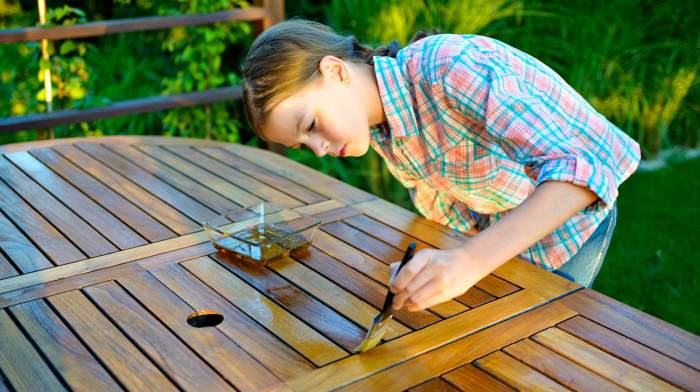Children’s woodworking projects offer a fantastic opportunity for kids to learn valuable skills, develop creativity, and have fun. From simple projects like building birdhouses to more complex ones like crafting furniture, woodworking allows children to explore their imagination and bring their ideas to life. This guide provides tips, ideas, and resources to help you embark on this exciting journey with your little woodworkers.
Safety is paramount when working with tools and wood. We’ll discuss essential safety measures, choosing age-appropriate projects, and providing guidance for safe work practices. We’ll also explore various woodworking techniques, inspire creativity with project ideas, and guide you through selecting the right tools and materials for your children’s woodworking adventures.
Safety First

Woodworking is a fun and rewarding hobby, but it’s important to prioritize safety, especially when working with children. By taking the necessary precautions, you can create a safe and enjoyable woodworking experience for everyone.
Safety Equipment
It’s essential to use appropriate safety equipment to protect yourself and your child from potential hazards.
- Safety Glasses: Protect your eyes from flying wood chips and debris. Choose safety glasses that fit snugly and offer good peripheral vision.
- Gloves: Protect your hands from splinters, cuts, and burns. Choose gloves that are comfortable and provide a good grip.
- Dust Mask: Protect your lungs from inhaling sawdust, which can be harmful to your health. Choose a dust mask that fits snugly and has a filter that can remove fine particles.
Choosing Age-Appropriate Tools and Materials
Selecting the right tools and materials is crucial for a safe woodworking experience.
- Tools: Start with basic tools like hand saws, hammers, and screwdrivers. As your child develops their skills, you can introduce more advanced tools like power drills and sanders.
- Materials: Use softwood like pine or cedar for your first projects. These woods are easier to work with and less likely to cause splinters.
Safe Work Practices
Safe work practices are essential to prevent accidents.
- Use Clamps: Secure your workpieces with clamps to prevent them from moving while you are cutting or sanding. This helps avoid accidental injuries.
- Avoid Loose Clothing: Make sure your child’s clothing is not loose or dangling. This prevents it from getting caught in machinery or tools.
- Supervise Children Closely: Never leave a child unsupervised while they are working with tools. Keep a close eye on their progress and provide guidance as needed.
Exploring Different Woodworking Techniques
Woodworking offers a world of possibilities, and mastering various techniques can elevate your projects from simple to stunning. Let’s explore some essential woodworking techniques that will empower you to create amazing things.
Basic Woodworking Techniques
Basic woodworking techniques form the foundation for more intricate projects. These techniques are essential for understanding the behavior of wood and manipulating it to achieve desired shapes and forms.
- Sawing: Sawing is used to cut wood to size. Different types of saws, such as hand saws, circular saws, and jigsaws, are used for various purposes. Sawing requires careful planning and precise cuts to ensure accurate results.
- Sanding: Sanding smooths out rough surfaces and prepares wood for finishing. Different grit sandpaper is used for various stages of sanding, from coarse to fine. Sanding is crucial for achieving a smooth and even finish.
- Drilling: Drilling creates holes in wood for various purposes, such as attaching hardware, creating joints, or creating decorative elements. Different drill bits are used for different materials and sizes of holes.
- Finishing: Finishing protects wood from damage and enhances its appearance. Different types of finishes, such as paint, stain, and varnish, are used for different purposes and effects. Finishing requires careful application to ensure a uniform and durable finish.
Examples of Projects Utilizing Different Techniques
These techniques can be applied to create a wide variety of projects, from simple to complex. Let’s explore some examples:
- Carving: Carving involves using tools like chisels and gouges to remove wood and create intricate designs. A classic example is a wooden bird, where the details of the feathers and beak are achieved through precise carving.
- Turning: Turning involves rotating a piece of wood on a lathe while shaping it with various tools. A common example is a wooden bowl, where the smooth curves and symmetrical shape are achieved through turning.
- Inlay: Inlay involves embedding different materials, such as wood, metal, or stone, into a surface to create decorative patterns. An example is a wooden box with intricate floral patterns created by inlaying different woods.
Combining Multiple Techniques
Combining different woodworking techniques can lead to unique and challenging projects. Let’s imagine a project that involves multiple techniques:
- A Wooden Treasure Chest: This project could involve sawing, sanding, drilling, finishing, and carving. You could use a saw to cut the wood for the chest, sand it smooth, drill holes for hinges and a lock, finish it with a protective coat, and carve decorative details on the lid.
Tools and Materials for Children’s Woodworking

When embarking on woodworking projects with children, selecting the right tools and materials is crucial for both safety and success. Choosing age-appropriate tools and understanding the properties of different wood types will ensure a positive and enriching experience.
Tools for Children’s Woodworking
- Safety Glasses: Always wear safety glasses to protect your eyes from flying wood chips or debris.
- Hand Saw: A hand saw with a blunt blade is ideal for children. This allows them to practice sawing without the risk of sharp edges.
- Hammer: A small hammer with a rubber mallet head is safer for children to use. This reduces the risk of injuries from forceful blows.
- Screwdriver: Choose a screwdriver with a comfortable grip and a variety of interchangeable tips.
- Measuring Tape: A measuring tape helps children accurately measure and cut their wood pieces.
- Clamps: Clamps are essential for holding wood pieces securely in place during cutting or assembly.
- Sandpaper: Sandpaper is used to smooth rough edges and create a polished finish.
- Wood Glue: Wood glue is used to bond wood pieces together. It is important to use a non-toxic and water-based glue that is safe for children.
- Pencil: A pencil is used to mark wood pieces for cutting or drilling.
- Workbench: A sturdy workbench provides a stable and safe working surface for children.
Recommended Wood Types
- Pine: Pine is a softwood that is easy to work with and relatively inexpensive. It is a good choice for beginners and smaller projects.
- Basswood: Basswood is another softwood that is known for its smooth texture and ease of carving. It is suitable for detailed projects and sculptures.
- Birch: Birch is a hardwood that is strong and durable. It is a good choice for projects that require a sturdy and long-lasting finish.
- Maple: Maple is a hardwood that is known for its beautiful grain pattern. It is a popular choice for furniture and other decorative items.
Importance of Quality Tools and Materials
Investing in high-quality tools and materials is essential for safety and durability.
Good tools are designed to be safe and efficient, while quality materials will ensure that projects last longer.
Using cheap or poorly made tools can lead to accidents, while using low-quality wood may result in weak and unstable projects.
Resources and Support for Woodworking with Children: Children’s Woodworking Projects

It’s fantastic that you’re interested in woodworking with children! There are many resources and support systems available to help you make this a fun and safe experience.
Online Resources and Tutorials
There are numerous online resources that provide step-by-step instructions for children’s woodworking projects. These resources offer a variety of project ideas, from simple crafts to more complex builds. They often include detailed instructions, illustrations, and even videos to guide you through each step.
- YouTube: A vast library of woodworking tutorials, many geared towards beginners and children. Search for “kids woodworking projects” or “easy woodworking projects for beginners.”
- Pinterest: A visual search engine with a wealth of project ideas and inspiration. Search for “kids woodworking projects” or “woodworking projects for beginners.”
- Woodworking Websites: Several websites are dedicated to woodworking, including those specifically for children. These sites often offer free plans, tutorials, and articles on woodworking techniques. Some popular examples include:
- Ana White: Provides free woodworking plans, including many kid-friendly projects.
- The Wood Whisperer: Offers a variety of woodworking tutorials, including some for beginners.
Local Woodworking Clubs and Organizations
Connecting with local woodworking clubs or organizations can be a great way to find workshops and classes for children. These groups often offer beginner-friendly classes, access to tools and equipment, and a supportive community of woodworkers.
- Local Libraries: Many libraries host woodworking workshops or classes for children. Check your local library’s website or calendar of events.
- Community Centers: Community centers often offer woodworking programs for children. Contact your local community center for more information.
- Woodworking Clubs: Search online for woodworking clubs in your area. Many clubs welcome families and offer programs for children.
Online Woodworking Communities, Children’s woodworking projects
Joining online woodworking communities can be a great way to find inspiration, get support, and connect with other woodworkers. These communities are a valuable resource for sharing ideas, asking questions, and getting feedback on projects.
- Forums: Online forums dedicated to woodworking provide a platform for discussion and advice. Popular examples include:
- Lumberjocks: A large online community for woodworkers.
- Reddit’s r/woodworking: A subreddit dedicated to woodworking.
- Social Media: Many woodworkers share their projects and experiences on social media platforms like Facebook, Instagram, and Twitter. Follow woodworking accounts and join woodworking groups for inspiration and support.
Final Wrap-Up

With a little guidance and a whole lot of enthusiasm, children’s woodworking projects can be a rewarding experience for both kids and parents. From the satisfaction of creating something with their own hands to the joy of seeing their creations come to life, woodworking offers countless benefits for young minds. So, grab your tools, gather your supplies, and get ready to embark on a journey of creative woodworking with your children.
FAQ Insights
What are some basic woodworking tools for kids?
Start with safe and easy-to-use tools like hammers, screwdrivers, hand saws, clamps, and sandpaper. As children gain experience, you can introduce more advanced tools.
What types of wood are best for children’s projects?
Softwoods like pine, cedar, and fir are ideal for beginners due to their ease of working. Hardwoods like oak and maple can be used for more advanced projects.
How can I make woodworking projects more engaging for kids?
Involve them in every step, from planning and design to finishing. Let them choose colors, finishes, and embellishments to personalize their projects. Celebrate their successes and encourage their creativity.
Children’s woodworking projects are a fun and rewarding way to teach them about tools and creativity. If you’re looking for some inspiration, check out these woodworking craft plans which are perfect for kids of all ages. From simple birdhouses to more complex toys, there’s something for everyone.
With a little guidance, your kids can create their own unique masterpieces!
